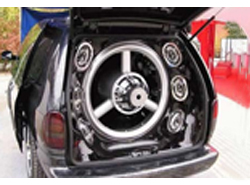
Do:
Carefully assess the mid-range of the element. There’s all sorts of good stuff living in that mid-range, and often times it’s going to want to come out.
Whether it’s giving the kick punch in the low-mid region, or sharpening the attack at the treble area, or enhancing the gritty overtones of the bass in the mid-mids – check it out.
Go with what feels right. Boosting mid-range won’t make the low element bassier, but it may give it more presence in the mix and draw attention to the low end.
Use the low-pass filter when appropriate. You only need one bass element to have a lot of high end, the rest is probably going to get buried under the mid-range instruments anyway – so get that high end out of the way and emphasize that deep low.
Get aggressive. The low end is an open canvas for heavy processing. Even a completely flat, sustaining bass instrument can sound awesome over-driving into a compressor. The overtones activate and you get something just as flat, but a lot buzzier.
Be careful with your compression on kick drums, specifically. You want a solid amount of attack to keep that kick drum drawing your attention, and a solid sustain to give that drum weight. It’s hard to get both. And often times, though not always, the release of the kick doesn’t sound so hot – unless you want that really trashy, weighty kick drum. Which can be cool.
Embrace the sine wave tone. Sine waves are pure concentrated bass. They sound pretty great layered under a bass line, or gated to a kick. Just make sure the sine wave is playing the appropriate tones. Guess what – if your chord is changing throughout the song, that means the root that the bass resonates best at changes – so program your sine wave accordingly!
Don’t:
Don’t carve out low frequencies to make room for other low elements. Bass doesn’t work this way too often. If you are carving out frequencies, do it because there’s an excessive resonance there, or because there’s sub build up.
Don’t be afraid of narrow boosts. Convention seems to say that you should boost wide. But in the low range – wide becomes very relative. Remember, there’s less space in the low range – so a wide bandwidth is going to be super wide. Also, narrow boosts can help emphasize a good sub. Just be careful when choosing what narrow band – make sure it helps the bass element and fits properly in the context of the track.
Don’t freaking side chain every bass to every kick in every mix. Yes, ducking the bass from the kick can be a good way to get the kick in the open. However, the bass should be SUPPORTING the kick. And if it’s supporting the kick, and you duck it out of the way – there goes your support.
Also, remember that ducking has rhythmic consequences. In certain styles, where the kick is coming in regular intervals – this can be cool. When the kick doesn’t come in regular intervals, or very close together, you start losing definition of that rhythm. I actually like to do the opposite.
Long sustaining bass lines tend to have very little movement, and don’t always aid the rhythm. I’ll side-chain an expander, or an upward expander to the kick – so when the kick hits, the bass jumps a little with it.
Matthew Weiss records, mixes, and masters music in the Philadelphia, New York, and Boston areas. Find out more about him here.
Be sure to visit the ProAudioFiles for more great recording content.
